What Is the Best Insulation For Your Crawl Space?
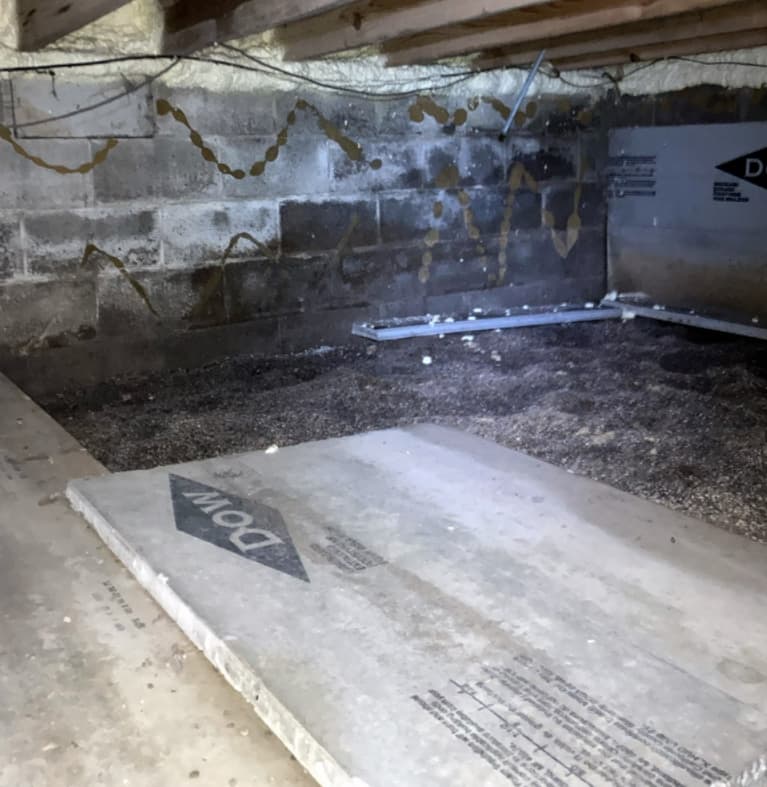
Originally published 2/2/22; updated 10/17/23
Are you paying higher energy bills but still have cold floors? Does your home have a musty smell that gets worse when your HVAC turns on? These could be signs that you need to reevaluate — or replace — your crawl space insulation.
Crawl spaces are often neglected because they’re “out of sight and out of mind.” But the uninhabited space below your floors can affect your home’s stability and overall health. Even worse, crawl space insulation — or its failure — may just be the beginning of your foundation problems.
Acculevel is a family-owned and operated company that specializes in foundation repair and waterproofing. Since our start in 1996, we’ve helped more than 35,000 homeowners preserve and protect their home’s foundation, health, and resale value.
In this article, we’re going to explore the common types of crawl space insulation, which ones are most effective, and which ones you should avoid.
What is the Best Way to Insulate a Crawl Space?
Let us be clear: fiberglass batting is a reasonable and affordable insulation choice in some parts of your home. Your crawl space is not one of them.
We feel very strongly about this because fiberglass batts will absorb moisture, and moisture damage is the number one cause of most crawl space issues. Please understand that unless a crawl space is encapsulated, it will get damp periodically. Most crawl spaces don’t have a true floor; they’re usually open to the dirt below, which allows ground moisture to intrude.
Why Do We Discourage Fiberglass Insulation?
- Most builders install insulation batting the floor joists. When the insulation gets damp, it’s holding moisture against your wooden joists and subfloor.
- Moisture causes wood to rot and decay. Damaged flooring components like joists and beams will cause sagging floors.
- Damp wood also attracts insects like termites, who are demolition experts in this field.
- Mold and organisms like bacteria and viruses need moisture to thrive. They can grow on the wood or in the insulation itself.
- Moisture buildup in fiberglass batts makes the insulation heavier. Eventually, it will weigh too much and pull free of its fasteners. Then your crawl space insulation is in the dirt, leaving your joists and flooring structure exposed to outside air.
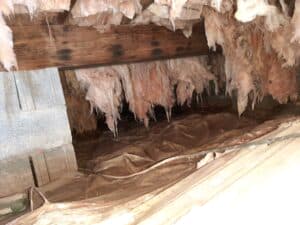
This photo was taken by an Acculevel project advisor during an in-home assessment for a homeowner. The fiberglass insulation has gotten damp, unraveled, and is falling down.
If you currently have fiberglass insulation in your crawl space, we advise you to have it removed and disposed of in a safe manner. Fiberglass materials are hazardous substances and cannot be tossed into your trash without precautions. Once this is done, you’ll need to inspect your floor joists, sill plate, and other wooden components for mold, decay, or insect damage.
Not sure how to properly inspect your crawl space and foundation for signs of damage? Use our free DIY Home Inspection Guide; it explains what to look for and how to detect problems.
Now that you’ve removed a potential threat to your floor’s structural integrity let’s discuss the types of crawl space insulation that will benefit you and your home.
Spray Foam is Ideal for Use in Crawl Spaces
Most builders and contractors agree that spray foam is a far better product for use in a potentially damp environment. This rigid foam insulation repels water and is resistant to biological growth.
At first glance, spray foam insulation is more expensive than fiberglass. Don’t be fooled by comparing the price per foot because the quantities you need are very different. It takes far less foam to effectively insulate your entire crawl space because it only needs to be installed in the joist boxes.
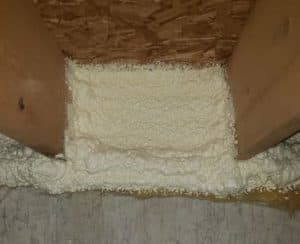
This photo was taken by an Acculevel team member after installing spray foam insulation in a homeowner’s crawl space.
Why Do You Only Need Foam In Joist Boxes?
Think about how your home is constructed. Your foundation is built of concrete, brick, or maybe even stone. All of these materials are thicker and better insulators than wooden boards.
The wooden flooring structure that is placed on top of your foundation is the weakest point. The diagram below shows the ideal spot for insulation is in the “joist box,” the point where the sill plate and band joist connect. What’s on the other side of the band joist? Depending on the depth of your crawl space, it’s either solid earth or siding.
If the joist box is above ground, it’s exposed to the outside air temperatures. Colder air can sneak its way through an uninsulated board; good insulation prevents this from happening.
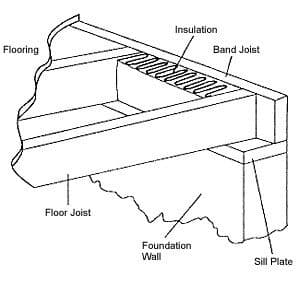
This illustration is courtesy of NCSU.
Do you have more questions about your wooden flooring structure, or have you noticed sloping or sagging in your floors? We talk about flooring components and repair costs here.
The ground maintains a more constant temperature than outdoor air, but it also emphasizes the need for waterproof insulation in the joist box. If the other side of the band joist is damp soil, it’s more likely the band joist and insulation will also be in contact with moisture.
Insulation for Crawl Space Walls Needs to Be Secure
If you have a drafty crawl space, you may also need to insulate the walls. This is especially true in homes with older foundations, or those made of brick or stone. As mortar ages, it can shrink and shift enough to create gaps.
Some homeowners will install foam board insulation to cover their crawl space walls, but this isn’t the most reliable method. Foam board is usually glued into place; glue placed on a damp surface is going to gradually lose effectiveness.
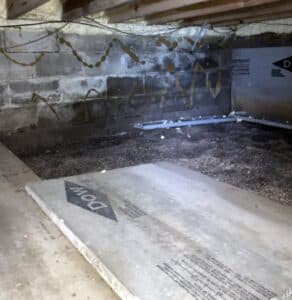
This photo was taken by an Acculevel project advisor during an in-home assessment. You can see the spray foam insulation is still secure in the joist boxes, but some of the foam board has fallen on the ground.
Blanket Insulation Is An Excellent Choice for Crawl Spaces
If you need to insulate your crawl space walls, blanket insulation is a more effective option. Blanket insulation is — as the name suggests — a cloth-like material that can be attached to foundation walls.
The “blanket” should be reflective on one side so that it deflects the colder air back towards the wall. This material should also be inorganic so that even if it gets wet, it won’t hold moisture or feed organisms like mold and bacteria.
Acculevel carries a type of blanket insulation called radiant armor. This wall insulation can be installed in any basement or crawl space, including in combination with encapsulation.
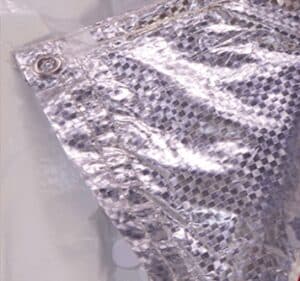
This is a close-up photo of Radiant Armor Insulation.
How Is Blanket Insulation Installed?
It’s not hung up like curtains or glued in place. The “blanket” is firmly attached to the wall so that it won’t fall down. The edges are sealed with seam tape to prevent gaps, but the blanket itself is attached to the wall with specific fasteners. The insulation is tear-resistant, so punctures for installation will not compromise it.
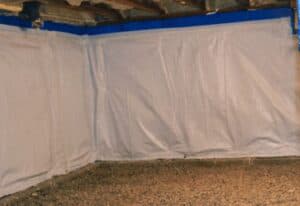
This is a photo of radiant armor after it’s been installed in a crawl space. You can see the blue seam tape around the edges; the wall fasteners are white.
What About the R-Values of These Crawl Space Insulation Types?
There are some different opinions about how accurate the R Value measurement system is, particularly when compared to insulation quality. However, since it’s the standard measurement used by the North American Insulation Manufacturers Association (NAIMA), that’s what we’ll provide.
| Insulation Type | R Value |
| Fiberglass batting (between floor joists) | 2.8 – 3.9 |
| Spray Foam (in joist boxes) | 5.5 – 7.12 |
| Foam Board (applied to walls) | 3.5 – 4.2 |
| Blanket Insulation (hung on walls) | 8.73 |
Clearly, insulating a crawl space thoroughly can significantly reduce cold air and energy loss. Installing insulation may be the game changer you need to lower your energy costs and have a cozier winter.
Don’t Neglect Your Crawl Space Floor
This isn’t a recommendation for how to insulate a crawl space, but it’s still crucial information for homeowners. While encapsulation is not required, a vapor barrier is the bare minimum layer you should have installed in your crawl space.
A vapor barrier is a liner that covers the ground under your home. This simple but crucial layer will reduce the vapors, gasses, and moisture that escape from the soil into your crawl space. This helps protect your flooring structure as well as your indoor air quality. We talk more about the importance of vapor barriers in crawl spaces in this article.
Do You Have Other Questions About Your Crawl Space?
We have a comprehensive homeowner’s guide to crawl space repairs, available free of charge to anyone who has questions or concerns. This guide is designed to address everything from mold growth to foundation issues, including repair methods and costs.
Would You Like a Professional Evaluation of Your Crawl Space?
Complete our online contact form or call 866-953-1501. We have helped more than 35,000 homeowners throughout Indiana and the surrounding areas preserve and protect their homes for the future.
When you contact Acculevel, we’ll make an appointment for you with one of our project advisors. They will sit down and discuss your concerns, your plans for your home, and the symptoms that you have experienced. Then they will thoroughly evaluate your home, diagnosing the problems and determining the best solution(s) for you.
Our goal is to provide you with a whole-home solution, a plan that addresses your complaints and will resolve them as efficiently as possible. We will treat your home as if it were our own, offering 5-star service every step of the way.
Don’t Live In The Midwest?
If you do not live in our service area, please make sure you are working with a reputable and properly insured contractor. Verify that they are accredited by the Better Business Bureau, and check their reviews from multiple sources.
You are also welcome to use our checklist of Questions You Should Ask a Contractor; please use this to protect yourself from potential scam artists and be certain you are working with a business that is the right fit for you.
